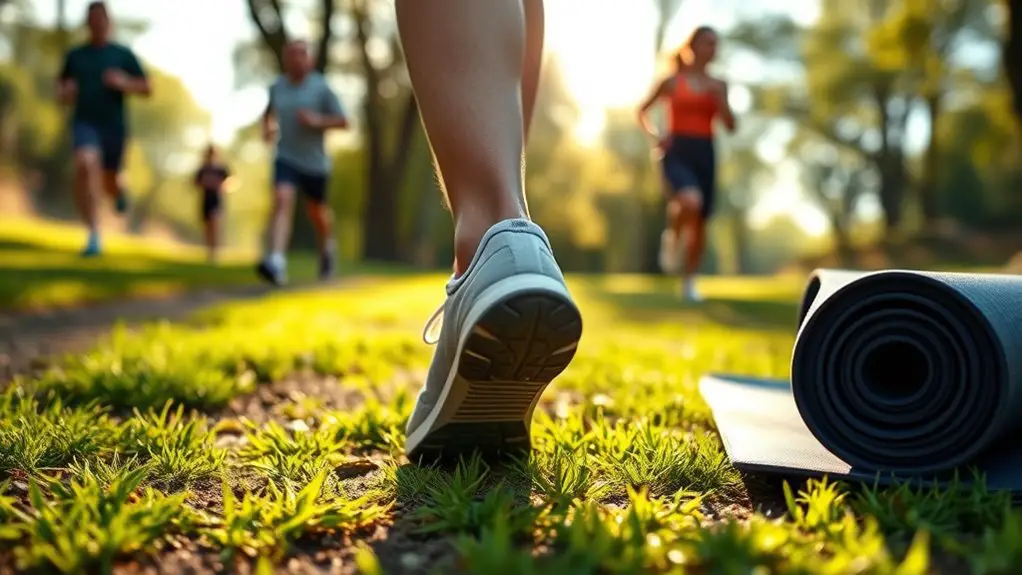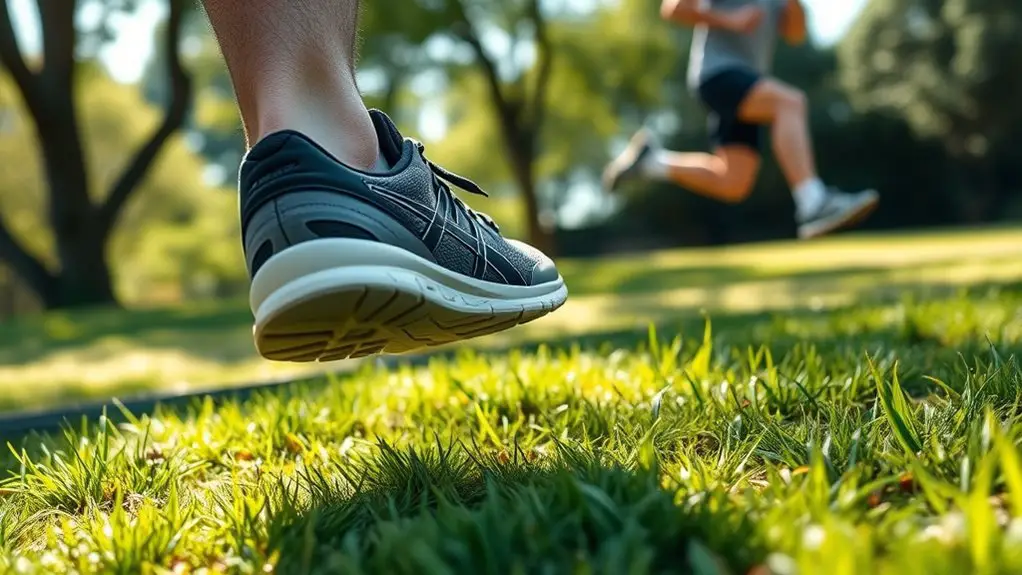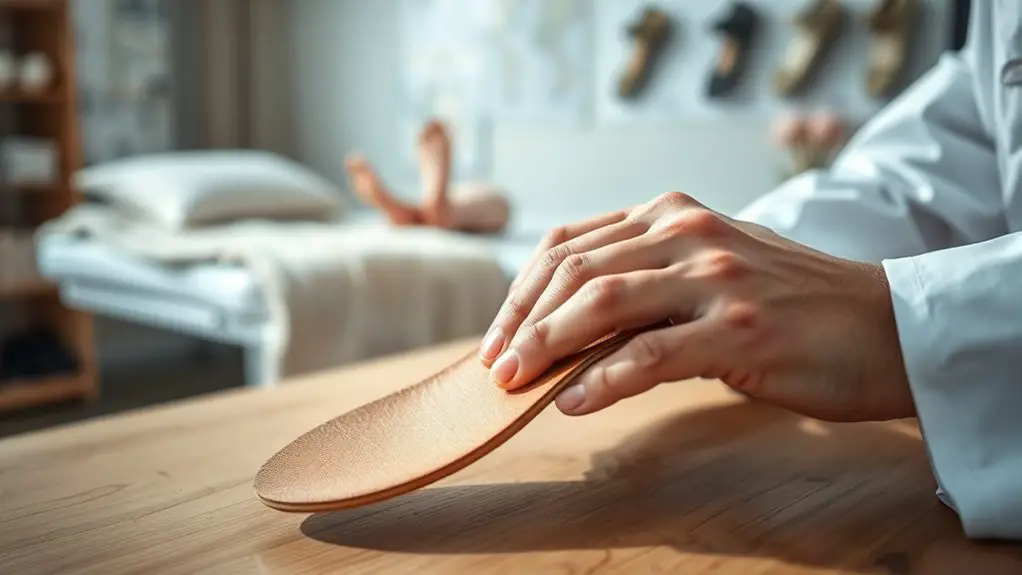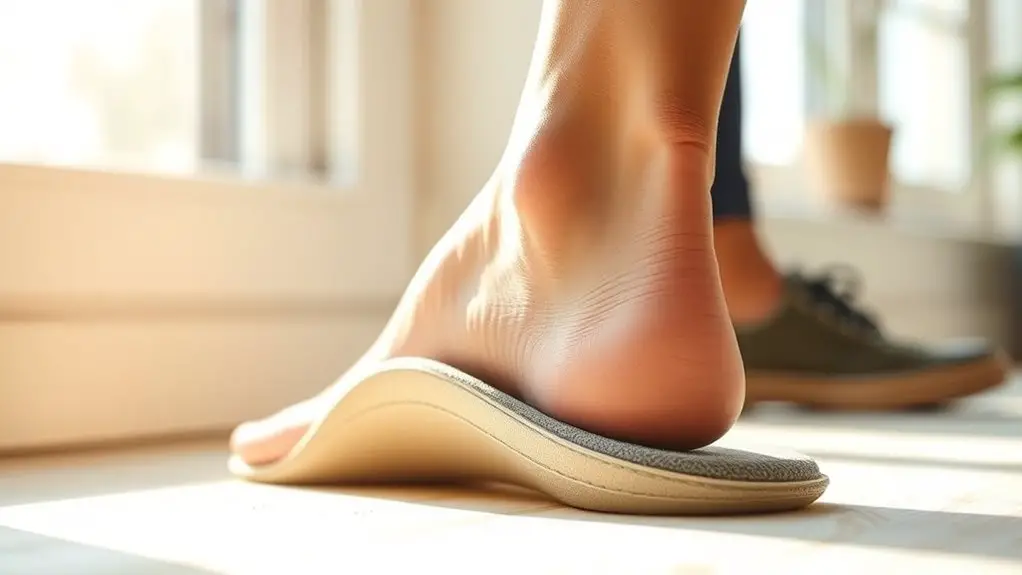To reduce heel pressure on your knees, choose footwear that provides sufficient arch support and cushioning. Adjust your walking or running technique by aiming for a midfoot strike and shortening your stride. Incorporating strengthening and stretching exercises will enhance muscle support around your knees. It’s also important to seek professional guidance if discomfort persists, as targeted therapy can address specific issues effectively. Discover additional strategies and insights for maintaining knee health.
Understanding the Connection Between Heel Pressure and Knee Pain

While you may not realize it, the pressure your heels endure can greatly impact your knees. When you walk or run, the heel strike phase generates force that travels up through your lower limbs. This force can alter knee alignment, particularly if your foot mechanics are compromised. Misalignment often leads to uneven weight distribution, placing excessive stress on your knees.
If your heels experience high pressure during each step, it can exacerbate existing knee issues or even contribute to new ones. Understanding the connection between heel pressure and knee pain is essential for injury prevention. For instance, if your heel strike is too forceful or misaligned, it can disrupt the natural biomechanics of your legs.
Choosing the Right Footwear for Optimal Support
Choosing the right footwear is essential for reducing heel pressure and supporting knee health, as improper shoes can exacerbate alignment issues. When selecting shoes, consider the footwear materials and their ability to provide adequate arch support, which helps distribute weight evenly and reduces stress on your knees.
| Footwear Type | Key Features |
|---|---|
| Running Shoes | Cushioned soles, arch support |
| Hiking Boots | Sturdy, supportive materials |
| Athletic Sneakers | Breathable, flexible design |
| Work Boots | Reinforced arch support, durability |
| Casual Shoes | Lightweight, moderate arch support |
Opt for shoes with a cushioned insole and good arch support to alleviate heel pressure. Remember, the right choice can greatly impact your knee health, enhancing your overall comfort during daily activities.
Adjusting Your Walking and Running Technique

Even with the right footwear, improper walking or running technique can still lead to excessive heel pressure and knee strain. Adjusting your technique is vital for alleviating this pressure. Focus on the following aspects:
Improving your walking or running technique is essential to reduce heel pressure and knee strain.
- Foot strike: Aim for a midfoot or forefoot strike instead of a heel strike to minimize impact.
- Stride length: Shorten your stride to reduce the force transmitted through your knees with each step.
- Cadence: Increase your step frequency to maintain a smoother, more efficient gait.
- Posture: Keep your head up and shoulders relaxed to promote better alignment and balance.
Incorporating Strengthening and Stretching Exercises
To effectively reduce heel pressure on your knees, incorporating a routine of strengthening and stretching exercises is essential. Strengthening exercises focus on the muscles surrounding the knee and ankle, which provide better support and stability. Exercises like leg lifts, calf raises, and squats can enhance muscle endurance and reduce stress on the joints.
In addition, implementing stretching techniques is vital for maintaining flexibility and preventing muscle tightness. Target areas such as the calves, hamstrings, and quadriceps to improve overall mobility. Incorporate stretches like the calf stretch and hamstring stretch into your routine to alleviate tension and promote proper alignment.
Aim for a balanced approach by dedicating time to both strengthening and stretching exercises. Consistency is key; performing these routines several times a week can greatly impact heel pressure on your knees, leading to improved function and reduced discomfort. Prioritize this practice for long-term knee health.
Seeking Professional Guidance for Persistent Issues

If heel pressure on your knees persists despite your efforts with exercises and stretches, seeking professional guidance can be essential. Engaging in physical therapy or seeking expert consultation may provide the relief you need. A qualified professional can assess your condition thoroughly and tailor a treatment plan that addresses your unique situation.
Consider the following benefits of professional guidance:
- Personalized assessment: Understanding the specific causes of your heel pressure.
- Targeted therapy: Implementing exercises tailored to strengthen supporting muscles.
- Pain management: Learning techniques to alleviate discomfort effectively.
- Education: Gaining insights into proper biomechanics and footwear choices.
Don’t hesitate to reach out for help if your symptoms continue. A professional’s expertise can facilitate a more effective recovery process, ensuring you return to your activities pain-free and with improved knee health.
Frequently Asked Questions
What Are Common Symptoms of Heel Pressure Affecting the Knees?
When heel discomfort strikes, you might notice knee pain, swelling, or stiffness. An impact assessment can reveal how pressure from your heels affects your knees, leading to potential long-term issues if left unaddressed.
How Does Body Weight Influence Heel Pressure on the Knees?
Body weight greatly influences heel pressure on your knees. Increased body mass alters weight distribution, leading to higher forces on your heel, which can exacerbate discomfort and strain in the surrounding knee structures during movement.
Can Heel Pressure Lead to Other Joint Problems?
Imagine a tightrope walker, struggling to maintain balance. Heel pain can disrupt joint alignment, leading to compensatory movements that strain other joints, ultimately causing issues like arthritis or tendonitis if left unaddressed.
Are There Specific Age Groups More Susceptible to Heel Pressure Issues?
Yes, elderly individuals often experience more heel pressure issues due to weakened structures. Additionally, during childhood development, inadequate footwear can lead to improper foot mechanics, increasing susceptibility to heel-related problems in both age groups.
What Role Does Surface Type Play in Heel Pressure and Knee Pain?
Imagine walking on clouds versus concrete; surface materials greatly affect heel pressure and knee pain. Softer surfaces enhance impact absorption, reducing stress, while harder surfaces amplify it, leading to discomfort and potential injury over time.



